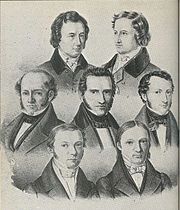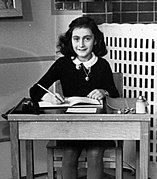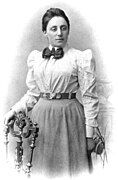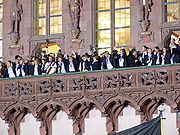Portal:Germany/Selected article/2008
These articles have appeared on the Portal:Germany page in 2008.

Knut (5 December 2006 – 19 March 2011) was a polar bear who was born in captivity at the Berlin Zoological Garden. Rejected by his mother at birth, he was raised by zookeepers. He was the first polar bear cub to survive past infancy at the Berlin Zoo in more than 30 years. At one time the subject of international controversy, he became a tourist attraction and commercial success. After the German tabloid newspaper Bild ran a quote from an animal rights activist that decried keeping the cub in captivity, fans worldwide rallied in support of his being hand-raised by humans.
Knut became the center of a mass media phenomenon dubbed "Knutmania" that spanned the globe and spawned toys, media specials, DVDs, and books. Because of this, the cub was largely responsible for a significant increase in revenue, estimated at about five million euros, at the Berlin Zoo in 2007. Zoo attendance figures for the year had increased by an estimated 30 percent. On 19 March 2011, Knut died unexpectedly at the age of four. His death was caused by drowning after he collapsed into his enclosure's pool while suffering from encephalitis. More ...

The Göttingen Seven (German: Göttinger Sieben) were a group of seven liberal professors at University of Göttingen. In 1837, they protested against the annulment of the constitution of the Kingdom of Hanover by its new ruler, King Ernest Augustus, and refused to swear an oath to the king. The company of seven was led by historian Friedrich Christoph Dahlmann, who himself was one of the key advocates of the previous constitution. The other six were the Germanist brothers Wilhelm and Jacob Grimm, famed collectors and publishers of folklore, known collectively as the Brothers Grimm, jurist Wilhelm Eduard Albrecht, historian Georg Gottfried Gervinus, physicist Wilhelm Eduard Weber, and theologian and orientalist Heinrich Georg August Ewald. (Full article...)

The Free Association of German Trade Unions (abbreviated FVdG; sometimes also translated as Free Association of German Unions or Free Alliance of German Trade Unions) was a trade union federation in Imperial and early Weimar Germany. It was founded in 1897 in Halle under the name Representatives' Centralization of Germany as the national umbrella organization of the localist current of the German labor movement. The localists rejected the centralization in the labor movement following the sunset of the Anti-Socialist Laws in 1890 and preferred grassroots democratic structures. The lack of a strike code soon led to conflict within the organization. Various ways of providing financial support for strikes were tested before a system of voluntary solidarity was agreed upon in 1903. During the years following its formation, the FVdG began to adopt increasingly radical positions. During the German socialist movement's debate over the use of mass strikes, the FVdG advanced the view that the general strike must be a weapon in the hands of the working class. Immediately after the November Revolution, the FVdG very quickly became a mass organization. It was particularly attractive to miners from the Ruhr area opposed to the mainstream unions' reformist policies. In December 1919, the federation merged with several minor left communist unions to become the Free Workers' Union of Germany (FAUD). More...

Michael Schumacher (German: [ˈmɪçaːʔeːl ˈʃuːmaxɐ] ; born 3 January 1969) is a German former racing driver, who competed in Formula One from 1991 to 2006 and from 2010 to 2012. Schumacher won a record-setting seven Formula One World Drivers' Championship titles, a record which was tied by Lewis Hamilton in 2020. At the time of his retirement, Schumacher held the records for most wins (91), pole positions (68), and podium finishes (155), while he maintains the record for most fastest laps (77), among others.
Born in Hürth to a working-class family, Schumacher started his career in kart racing aged four. He won his first karting title two years later in a kart built from discarded parts. After having enjoyed success in karting—such as winning the direct-drive Karting European Championship in 1987—and in several single-seater series, Schumacher made a one-off Formula One appearance with Jordan at the 1991 Belgian Grand Prix. He was signed by Benetton for the rest of the 1991 season, winning his first and second drivers' titles consecutively in 1994 and 1995 with the team. Schumacher moved to the struggling Ferrari team in 1996. During his first few years with the team, Schumacher lost out on the title in the final race of the season in 1997 and 1998, and suffered a broken leg from a brake failure in 1999. He and Ferrari won five consecutive titles from 2000 to 2004, including unprecedented sixth and seventh titles, while breaking several records. After finishing third in 2005 and second in 2006, Schumacher retired from the sport, although he later made a brief return with Mercedes from 2010 to 2012. (Full article...)

Auschwitz concentration camp (German: Konzentrationslager Auschwitz, pronounced [kɔntsɛntʁaˈtsi̯oːnsˌlaːɡɐ ˈʔaʊʃvɪts] ; also KL Auschwitz or KZ Auschwitz) was a complex of over 40 concentration and extermination camps operated by Nazi Germany in occupied Poland (in a portion annexed into Germany in 1939) during World War II and the Holocaust. It consisted of Auschwitz I, the main camp (Stammlager) in Oświęcim; Auschwitz II-Birkenau, a concentration and extermination camp with gas chambers; Auschwitz III-Monowitz, a labour camp for the chemical conglomerate IG Farben; and dozens of subcamps. The camps became a major site of the Nazis' Final Solution to the Jewish question.
After Germany initiated World War II by invading Poland in September 1939, the Schutzstaffel (SS) converted Auschwitz I, an army barracks, into a prisoner-of-war camp. The initial transport of political detainees to Auschwitz consisted almost solely of Poles (for whom the camp was initially established). For the first two years, the majority of inmates were Polish. In May 1940, German criminals brought to the camp as functionaries established the camp's reputation for sadism. Prisoners were beaten, tortured, and executed for the most trivial of reasons. The first gassings—of Soviet and Polish prisoners—took place in block 11 of Auschwitz I around August 1941. (Full article...)

The Battle of Schellenberg, also known as the Battle of Donauwörth, was fought during the War of the Spanish Succession on 2 July 1704. The assault on the Schellenberg heights on the River Danube was part of the Duke of Marlborough’s campaign to rescue Vienna, the capital of Habsburg Austria, from King Louis XIV's forces ranged in southern Germany. Marlborough had commenced his march from Bedburg, near Cologne, on 19 May; within five weeks the Duke had reached the Danube where he sought to bring the Elector of Bavaria's forces to open battle. However, the Allied army’s lines of supply were established in Franconia and central Germany, too far north to be convenient once the line of the Danube had been crossed. It was therefore necessary not only to secure a bridge across the river, but also to obtain a new supply base. To achieve these objectives, the Allied commanders chose the walled town of Donauwörth, overlooked by the fortress on the Schellenberg Heights. Once the Franco-Bavarian commanders knew of the Allies’ objective, they dispatched Count d’Arco with 12,000 men to strengthen and hold the position. Marlborough’s co-commander, Louis of Baden, preferred a protracted siege; however, with news arriving that Marshal Tallard was approaching with French reinforcements, the Duke insisted on an immediate assault. Within two hours the Allies had secured their objective, but at considerable cost; the coup de main had cost the Allies some 5,000 casualties, and the defenders, 8,000. Nevertheless, with a supply base and river crossing firmly secured, the Duke of Marlborough – soon to be reinforced by Prince Eugene of Savoy – could now fight the battle he had desired. More...

Annelies Marie "Anne" Frank (German: [ˈanə(liːs maˈʁiː) ˈfʁaŋk] , Dutch: [ˌɑnəˈlis maːˈri ˈfrɑŋk, ˈɑnə ˈfrɑŋk] ; 12 June 1929 – c. February or March 1945) was a German-born Jewish girl who kept a diary documenting her life in hiding amid Nazi persecution during the German occupation of the Netherlands. A celebrated diarist, Frank described everyday life from her family's hiding place in an Amsterdam attic. She gained fame posthumously and became one of the most-discussed Jewish victims of the Holocaust with the 1947 publication of The Diary of a Young Girl (originally Het Achterhuis in Dutch, lit. 'the back house'; English: The Secret Annex), which documents her life in hiding from 1942 to 1944. It is one of the world's best-known books and has been the basis for several plays and films.
Frank was born in Frankfurt, Germany, in 1929. In 1934, when she was four-and-a-half, Frank and her family moved to Amsterdam in the Netherlands after Adolf Hitler and the Nazi Party gained control over Germany. By May 1940, the family was trapped in Amsterdam by the German occupation of the Netherlands. Frank lost her German citizenship in 1941 and became stateless. Despite spending most of her life in the Netherlands and being a de facto Dutch national, she never officially became a Dutch citizen. As persecutions of the Jewish population increased in July 1942, the family went into hiding in concealed rooms behind a bookcase in the building where Frank's father, Otto Frank, worked. The hiding place is notably referred to as the "secret annex". Until the family's arrest by the Gestapo on 4 August 1944, Frank kept and regularly wrote in a diary she had received as a birthday present in 1942. (Full article...)

The flag of Germany is a tricolour consisting of three equal horizontal bands displaying the national colours of Germany: black, red and gold.
The black-red-gold tricolour first appeared in the early 19th century and achieved prominence during the 1848 revolution. The short-lived Frankfurt Parliament of 1848–50 proposed the tricolour as a flag for a united and democratic German state. With the formation of the Weimar Republic after World War I, the tricolour was adopted as the national flag of Germany. Following World War II, the tricolour was designated as the flag of both West and East Germany. The two flags were identical until 1959, when socialist symbols were added to the East German flag. Since reunification on 3 October 1990, the black-red-gold tricolour has remained the flag of Germany.
The flag of Germany has not always used black, red and gold as its colours. After the Austro–Prussian War in 1866, the Prussian-dominated North German Confederation adopted a tricolour of black-white-red as its flag. This flag later became the flag of the German Empire, formed following the unification of Germany in 1871, and was used until 1918. Black, white and red were reintroduced as the German national colours with the establishment of Nazi Germany in 1933.
The colour schemes of black-red-gold and black-white-red have played an important role in the history of Germany and have had various meanings. The colours of the modern flag are associated with the republican democracy formed after World War II, and represent German unity and freedom: not only the freedom of Germany, but also the personal freedom of the German people. More...

Amalie Emmy Noether (March 23, 1882 – April 14, 1935) was a German Jewish mathematician who is known for her seminal contributions to abstract algebra. Often described as the most important woman in the history of mathematics, she revolutionized the theories of rings, fields, and algebras. She is also known for her contributions to modern theoretical physics, especially for the first Noether's theorem which explains the connection between symmetry and conservation laws.
After completing her dissertation in 1907 under the supervision of Paul Gordan, she worked at the Mathematical Institute of Erlangen without pay for seven years. In 1915, she was invited by David Hilbert and Felix Klein to join the mathematics department at the University of Göttingen. The Philosophical faculty objected, however, and she spent four years lecturing under Hilbert's name. Her Habilitation process was approved in 1919, paving the way for her to obtain the rank of Privatdozent. She remained at Göttingen until 1933, where she was a leading member of a world-renowned center of mathematical research. By the time she delivered a major address at the 1932 International Congress of Mathematicians in Zürich, her algebraic acumen was recognized around the world. The following year, Germany's Nazi government had her fired from Göttingen, and she moved to the United States, where she took a position at Bryn Mawr College in Pennsylvania. In 1935, she underwent surgery for an ovarian cyst and, despite signs of speedy recovery, died four days later at the age of 53. More...

Nazi Germany, officially known as the German Reich and later the Greater German Reich, was the German state between 1933 and 1945, when Adolf Hitler and the Nazi Party controlled the country, transforming it into a totalitarian dictatorship. The Third Reich, meaning "Third Realm" or "Third Empire", referred to the Nazi claim that Nazi Germany was the successor to the earlier Holy Roman Empire (800/962–1806) and German Empire (1871–1918). The Third Reich, which the Nazis referred to as the Thousand-Year Reich, ended in May 1945, after only 12 years, when the Allies defeated Germany and entered the capital, Berlin, ending World War II in Europe.
After Hitler was appointed Chancellor of Germany by the President of the Weimar Republic Paul von Hindenburg on 30 January 1933, the Nazi Party began to eliminate political opposition and consolidate power. Hindenburg died on 2 August 1934, and Hitler became dictator by merging the powers of the chancellery and presidency. A 1934 German referendum confirmed Hitler as sole Führer (leader). Power was centralised in Hitler's person, and his word became the highest law. The government was not a coordinated, cooperating body, but rather a collection of factions struggling to amass power. In the midst of the Great Depression, the Nazis restored economic stability and ended mass unemployment using heavy military spending. Financed by deficit spending, the regime undertook extensive public works projects, including the Autobahnen (motorways) and a massive secret rearmament program, forming the Wehrmacht (armed forces). The return to economic stability boosted the regime's popularity. Germany made increasingly aggressive territorial demands, threatening war if they were not met. Germany seized Austria in the Anschluss of 1938, and demanded and received the Sudetenland region of Czechoslovakia. Germany signed a non-aggression pact with the Soviet Union and invaded Poland on 1 September 1939, launching World War II in Europe. In alliance with Italy and other Axis powers, Germany conquered most of Europe by 1940 and threatened Great Britain.
Racism, Nazi eugenics, anti-Slavism, and especially antisemitism were central ideological features of the regime. The Germanic peoples were considered by the Nazis to be the "master race", the purest branch of the Aryan race. Jews, Romani people, Slavs, homosexuals, liberals, socialists, communists, other political opponents, Jehovah's Witnesses, Freemasons, those who refused to work, and other "undesirables" were imprisoned, deported, or murdered. Christian churches and citizens that opposed Hitler's rule were oppressed and leaders imprisoned. Education focused on racial biology, population policy, and fitness for military service. Career and educational opportunities for women were curtailed. Nazi Propaganda Ministry disseminated films, antisemitic canards, and organized mass rallies; fostering a pervasive cult of personality around Adolf Hitler to influence public opinion. The government controlled artistic expression, promoting specific art forms and banning or discouraging others. Genocide, mass murder, and large-scale forced labour became hallmarks of the regime; the implementation of the regime's racial policies culminated in the Holocaust. (Full article...)

The Germany women's national football team (German: Deutsche Fußballnationalmannschaft der Frauen) represents Germany in international women's football. The team is governed by the German Football Association (DFB).
The Germany national team is one of the most successful in women's football. They are two-time world champions, having won the 2003 and 2007 tournaments. The team has won eight of the thirteen UEFA European Championships, claiming six consecutive titles between 1995 and 2013. They, along with the Netherlands, are one of the two nations that have won both the women's and men's European tournament. Germany has won Olympic gold in 2016, after three consecutive bronze medals at the Women's Olympic Football Tournament, finishing third in 2000, 2004 and 2008. Birgit Prinz holds the record for most appearances and is the team's all-time leading goalscorer. Prinz has also set international records; she has received the FIFA World Player of the Year award three times and is the joint second overall top goalscorer at the Women's World Cup. (Full article...)
